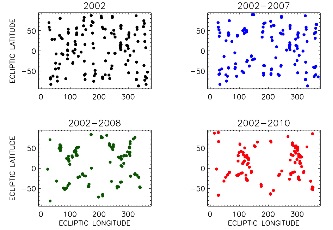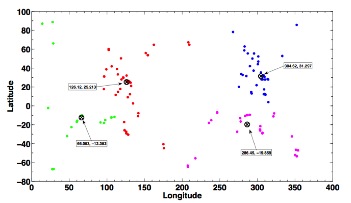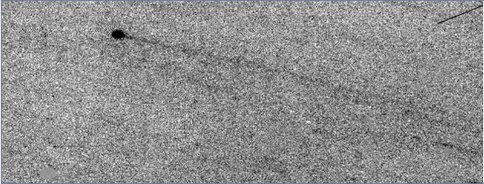2010 Annual Science Report
 University of Hawaii, Manoa
Reporting | SEP 2009 – AUG 2010
University of Hawaii, Manoa
Reporting | SEP 2009 – AUG 2010
Main Belt Comet Characterization
Project Summary
We are undertaking a comprehensive characterization of known main belt comets, an
important new class of volatile rich objects in the asteroid belt. These objects may retain
water from the early era of the solar system, and as such represent a reservoir of water that we have not yet sampled, and thus they may play an important role in understanding how volatiles got distributed to habitable worlds.
Project Progress
Main Belt Comet Characterization
Comets are icy relics left over from the planetary accretion disk. Most of them were scattered far out in the Oort Cloud, the scattered disk, or the Kuiper Belt during the early evolution of our solar system and only a few revolve on shorter orbits around the Sun. By investigating these most pristine bodies, we gain insight into processes and conditions in the early solar system and the subsequent evolution of small bodies. It is believed that comets played a role in the history of Earth’s evolution and may have contributed significantly to the water inventory we see today on Earth. A key goal of the University of Hawaii NASA Astrobiology Institute (UH NAI) is to investigate the origin, history and evolution of water in the solar system and its relation to life.
Main Belt Comets (MBCs) are a recently discovered and exciting new class of objects in our solar system. These small bodies reside within the asteroid belt between Mars and Jupiter and show both comet and asteroid like characteristics. Prior to this ices had not been thought to exist in the main belst Being closer to the Sun than Kuiper Belt or Oort Cloud comets, MBCs are an ideal sample with which we can study the longevity of ices in a region relatively close to the Sun. This is important for planet formation models; there is still considerable controversy over the location of the so-called “snow-line”, the region beyond which volatile ices began condensing and were incorporated into planetesimals. The location of the snow line has important implications for the origin and distribution of volatiles for habitable planets and is at the forefront of research in many areas: cosmochemistry and meteoritics, protoplanetary disk chemical models and disk observations. Moreover, they are accessible with low cost missions for in-situ exploration. Currently, only a handful of MBCs are known; it is thus crucial to learn as much about their physical properties in order to understand the mechanisms of their activity and make inferences about the origin and distribution of volatiles in the early solar system through thermal modeling and in-situ observations.
Observations of 176P/LINEAR: In some of our recent work on ice lifetime on these objects, the ability of ice to remain is a sensitive function of temperature. The distribution of heat on the surface depends on rotation period and obliquity of the spin axis. Between 12/13/2007 and 05/26/2009 comet 176P/LINEAR was targeted in eleven observing runs using the UH2.2m telescope facility on Mauna Kea, Hawaii. We are in the process of analyzing the rotation light curve (period 22.52 ± 0.6 hours) and constructing the heliocentric light curve from which we can develop outgassing models of the activity.
Observations of 133P/Elst-Pizarro: Having shown recurrent activity during the past three perihelion passages, it is now clear that in the case of the Main Belt comet 133P, the activity is the result of a thermally driven process. Our goal is to analyze data of 133P to obtain a precise understanding of the orbital, rotational and surface properties of this object in order to better understand its origin and long-term evolution. We are using observations ranging from 2002 to February 2010 to generate photometric light curves for 133P. The data were taken using the University of Hawai`i 2.2m telescope on Mauna Kea, the Faulkes Telescope North 2.0m on Haleakala, the Lowell Observatory Perkins 1.8m telescope on Anderson Mesa, Arizona as well as 3.6m New Technology Telescope in La Silla. The data were used to improve upon the measurements of 133P’s rotation period (3.4709 ± 0.0002 hours), as well as constrain the rotation pole orientation. Using the 2010 data set has drastically improved our estimates of the possible pole orientations as shown the accompanying figure. Two models attempt to explain the source of 133P’s activity using the sublimation of ices (Schorghofer, 2008, Prialnik & Rosenberg 2009) and both are able to independently show that water ice can survive in the nucleus only if its rotation axis is highly inclined (high obliquity) with respect to the orbital plane. By performing a cluster analysis, we see that the obliquity is high, which is consistent with the models and suggests that water ice is responsible for the observed activity in 133P. Using the same data set, we performed astrometry to measure non-gravitational accelerations. The results suggest that the outgassing is occurring from the sunlit hemisphere near perihelion, the activity is symmetric with respect to perihelion and that the southern hemisphere also has an active region. The astrometry was also used to derive, via a different technique, the pole orientation of 133P, which is also consistent with the results obtained via the light curves. The project is almost nearly complete. By using the data obtained we will obtain during January-Feb. 2011, we should be able to determine a unique pole orientation for 133P.
Observations of P/Garradd: Because of the intense interest in the MBCs as potential mission targets, it is important to have accurate orbits for all of them. However, with the exception of 133P/Elst-Pizarro which has been observed over 3 orbits, the observational arcs are short for the others. In conjunction with our Pan STARRS1 (PS1) telescope survey project to discover more MBCs we have secured follow-up time on large telescopes to verify activity in new objects. Because PS1 was not yet fully operational during spring 2010, we elected to use some of our large telescope allocation to recover MBC P/Garradd during April 2010. At the time, the prediction errors on its orbit had grown to be about as large as the typical imaging detectors, and it was in danger of being lost without significant observational effort. With 2 hours of integration we were able to recover the object at a very faint level. The implication for its size, assuming a typical comet surface reflectivity is that it has a radius of only 0.4 km.
Characterizing the new MBC C/2010 A2 LINEAR: When discovered in early 2010, this object had an orbit consistent with being a main belt comet, and an obvious debris or dust trail with a peculiar morphology, suggesting either a collision or Main Belt Cometary activity. Published observations of the angle of the tail placed the eruption at the beginning of 2009. Distinguishing between an MBC and an impact is important, because it would push the Solar System’s boundary for the presence of ice inward toward the Sun. We obtained Director’s Discretionary time on Gemini South to observe A2 Linear, and we also observed it from the NTT and the UH 2.2m. We modeled the precise shape of the trail, to see whether a cone-shaped expulsion could account for the shape of the observed dust distribution. We find that a conical eruption or collision event can indeed replicate our observations, and we find that the velocity, angle, and direction of the cone are well constrained (see figure). This work will be combined with published studies of collision debris profiles to make inferences about the composition of P/2010 A2 Linear. Furthermore, thermal models and dust-dynamical models are inconsistent with this being a thermally driven event. We expect to publish in early 2011.

These figures plot the evolving loci of possible rotation pole solutions in
sky coordinates, showing that the possible direction of the rotation pole is
getting refined as more data comes in.

The potential rotation pole solutions when all the data from 2002-2010 are
combined. Cluster analysis shows that the comet’s rotation axis has a
high inclination (i.e. it is tipped over significantly from the plane of its orbit).
Composite image obtained with the UH2.2m telescope on Mauna Kea.
Most of the field stars have been removed when making the composite, and
only a long narrow dust tail remains.
This is our best model conical ejection model fit to the observed dust envelope of P/2010 A2 Linear (red outline). To create this figure, we integrated conical dusty eruptions from Feb 2009 to Feb 2010, using different values for the direction of ejection, maximum dust velocity, and cone opening angle. The model shown is the one that best fits the observed dust of A2, using an objective numerical penalty function.
We recovered Garradd using two hours of Gemini GMOS data. After careful subtraction of background stars, a median stack of short exposures revealed a five sigma peak within four arcseconds of the expected position. Monte Carlo simulations at slightly incorrect rates showed that the detection was real with 99% certainty. The following figure is 18” high. Scale (bottom) is photons per pixel in 1 5 minute exposure.
-
PROJECT INVESTIGATORS:
-
PROJECT MEMBERS:
Karen Meech
Project Investigator
Jana Pittichova
Co-Investigator
Timm Riesen
Co-Investigator
Gal Sarid
Co-Investigator
Steve Chesley
Collaborator
Olivier Hainaut
Collaborator
Javier Licandro
Collaborator
Bin Yang
Collaborator
Anthony Zenn
Graduate Student
-
RELATED OBJECTIVES:
Objective 1.1
Formation and evolution of habitable planets.


